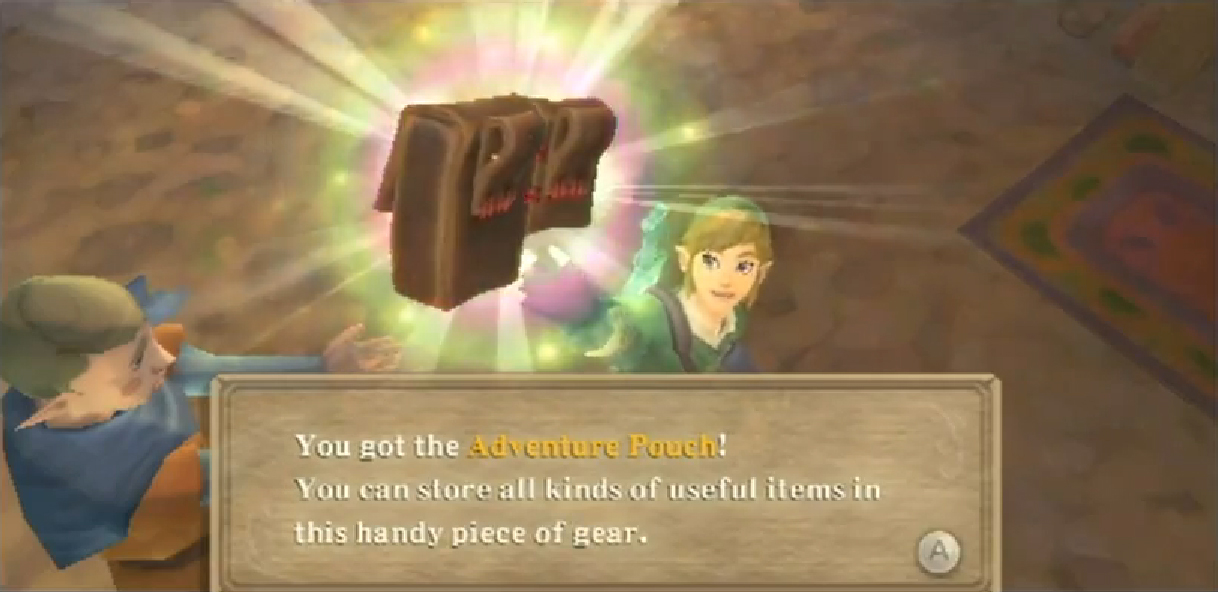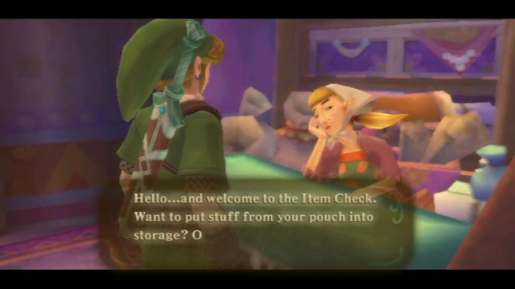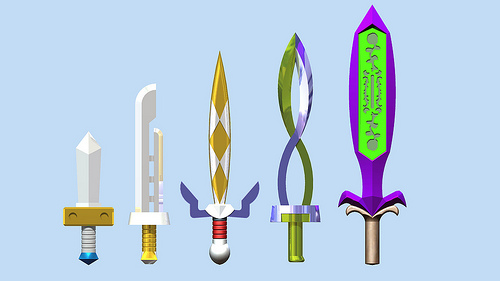An Analysis of Skyward Sword’s Adventure Pouch
Posted on March 30 2013 by Legacy Staff
 Among the many new features included in Skyward Sword was a refined inventory system. The addition of the Adventure Pouch made for some interesting choices when it came to resource management. The beginning of the game started the player off with four slots to fill with extra items, and that amount is doubled by the end. But that is about the peak of the Adventure Pouch’s significance: something extra. While the customization of Link is something that could lead to many creative opportunities, I do not believe that Skyward Sword tapped into this concept to its fullest potential.
Among the many new features included in Skyward Sword was a refined inventory system. The addition of the Adventure Pouch made for some interesting choices when it came to resource management. The beginning of the game started the player off with four slots to fill with extra items, and that amount is doubled by the end. But that is about the peak of the Adventure Pouch’s significance: something extra. While the customization of Link is something that could lead to many creative opportunities, I do not believe that Skyward Sword tapped into this concept to its fullest potential.
The intrigue of the Adventure Pouch can be attributed mainly to its limiting nature. Having a finite amount of space in which to carry items forces decisions to be made regarding which items will help out the most upon departing from Skyloft. This allows for a variety of different experiences to be had and thus increases replay value, which is always something to aspire to. Since the core of Skyward Sword’s gameplay did not always actively make use of this feature, however, it is often overlooked and hardly seen as a limitation. While you acquire more items that can be placed in the Adventure Pouch over the course of the game, you also acquire more slots in the pouch with which to store them. Although not a direct result of this, more important decisions involving the Adventure Pouch are made near the beginning of the game. Towards the start, while you only have four or five available spaces, your items are also weaker and less reliable.

Since all of the items kept within this portion of Link’s inventory are technically optional, there is very little weight to the decisions regarding what to carry. The different kinds of items that Link can store in the Adventure Pouch are quivers, seed satchels, bomb bags, medals, bottles and shields. Expansions on ammo holders are never necessary since if you need arrows, bombs, or the slingshot to solve a puzzle, an ammo drop is almost always nearby. When it comes down to combat, you will usually not need these items either since the sword is just as effective, if not more so. The medals were a nice addition harkening back to the rings in the Oracle games, some of which had some neat, helpful effects. Apart from the Life Medal though, they did not really do too much special besides make grinding-type tasks quicker and easier. Since bottles are probably the most powerful items in Zelda games (seeing as multiple can be carried, and thus multiple life saving fairies), it was nice to finally see some sort of limitation on them. The items that probably made the best use of the Adventure Pouch were the shields.
The first three obtainable shields in Skyward Sword all have glaring weaknesses. The Wooden Shield is susceptible to fire, the Iron Shield cannot protect against electricity, and the Sacred Shield has a much lower total shield meter. With fewer spaces available and less reliable items, the decision of what to carry becomes an important one. One might decide to carry two or three different kinds of shields along with their other items to assure that they are never defenseless. On the other hand, someone else might decide to take just one shield and some Revitalizing Potion. While these may not be the heaviest of decisions to make (mostly since shield bashing is pretty easy once you get the hang of it), it is much more thoughtful than what happens by the end of the game.
 There are certain optimal strategies that arise from the items that are confined to the Adventure Pouch, which is never desirable when designing game mechanisms. For example, the Hylian Shield almost single-handedly makes the Adventure Pouch devoid of any decision making. It has literally no weaknesses (unless you count the inability to shield bash on the player’s part), so you will never have to worry about it breaking, removing any consideration for including certain items in your pouch. By the end of the game, in theory one could take the Hylian Shield, all of the bottles filled with potions or fairies, and have two extra slots for medals or extra ammo. This negates the idea of limiting the inventory, since the player can still equip everything they need and more. Many will argue that since the Hylian Shield is an optional item and that it is obtained towards the end of the game it makes that all okay, but neither fact changes that it makes the game astronomically easier towards the end. For items to be balanced in an atmosphere of customization, each one needs to have unique strengths and weaknesses. If the Hylian Shield was to be balanced, for example, it would have needed to take up more space in the Adventure Pouch.
There are certain optimal strategies that arise from the items that are confined to the Adventure Pouch, which is never desirable when designing game mechanisms. For example, the Hylian Shield almost single-handedly makes the Adventure Pouch devoid of any decision making. It has literally no weaknesses (unless you count the inability to shield bash on the player’s part), so you will never have to worry about it breaking, removing any consideration for including certain items in your pouch. By the end of the game, in theory one could take the Hylian Shield, all of the bottles filled with potions or fairies, and have two extra slots for medals or extra ammo. This negates the idea of limiting the inventory, since the player can still equip everything they need and more. Many will argue that since the Hylian Shield is an optional item and that it is obtained towards the end of the game it makes that all okay, but neither fact changes that it makes the game astronomically easier towards the end. For items to be balanced in an atmosphere of customization, each one needs to have unique strengths and weaknesses. If the Hylian Shield was to be balanced, for example, it would have needed to take up more space in the Adventure Pouch.
What made the shield a great addition to the list of items kept in the Adventure Pouch is that is was the only one that was an integral part of the gameplay. The customization of things that actually make a difference in how you experience the important parts of the game is something that should be explored on a greater level. Skyward Sword experimented with having a main part of Link’s inventory both customizable and rich with options, and I would be interested in seeing this idea applied to all of Link’s items.
 Imagine a game in which Link has access to multiple types of each of his items but he was only able to carry a certain amount at a time. Specifically, he would be able to equip one sword, shield, tunic, and pair of boots at a time, as well as an array of his secondary weapons before setting off from his hometown each time he visits. To prevent abuse of this like present in Skyward Sword, each item would have certain strengths and weaknesses, and the more powerful an item is in general, the more space it would take up in Link’s inventory. This would allow for an extensive amount of new items which would lead to a great deal of variation. Many fans have been clamoring for multiple different swords since Majora’s Mask, and this could be a way to implement such a thing wisely. Many other Zelda games have functioned within a system where a new, better item will simply replace an older one. With this idea in effect, however, a great deal of new decisions could present themselves.
Imagine a game in which Link has access to multiple types of each of his items but he was only able to carry a certain amount at a time. Specifically, he would be able to equip one sword, shield, tunic, and pair of boots at a time, as well as an array of his secondary weapons before setting off from his hometown each time he visits. To prevent abuse of this like present in Skyward Sword, each item would have certain strengths and weaknesses, and the more powerful an item is in general, the more space it would take up in Link’s inventory. This would allow for an extensive amount of new items which would lead to a great deal of variation. Many fans have been clamoring for multiple different swords since Majora’s Mask, and this could be a way to implement such a thing wisely. Many other Zelda games have functioned within a system where a new, better item will simply replace an older one. With this idea in effect, however, a great deal of new decisions could present themselves.
Let’s say that Link has an inventory “weight” limit that stays constant throughout the game which, for the sake of discussion, is represented by the numerical value of 25. Each individual item would have its own weight of something between one and five, depending on how strong it is. It would be, in essence, similar to the Powers Grid in Kid Icarus Uprising. You could take a bunch of weaker items, or a few powerful ones, or a balance of the two approaches. For example, one could choose to take a weaker shield so that they could make room for a more powerful sword. A player could decide for themselves what works best or what is best suited to a certain situation. All in all, something like this could greatly help game balance while also creating a large amount of diversity and replayability.
Would you be keen on seeing an inventory system similar to that of Skyward Sword’s make a reappearance in Zelda Wii U? If so, do you think it could use some fine tuning, or was it fine just the way it was? If not, what didn’t you like about the Adventure Pouch? I’d love to hear all your thoughts and opinions in the comments!



